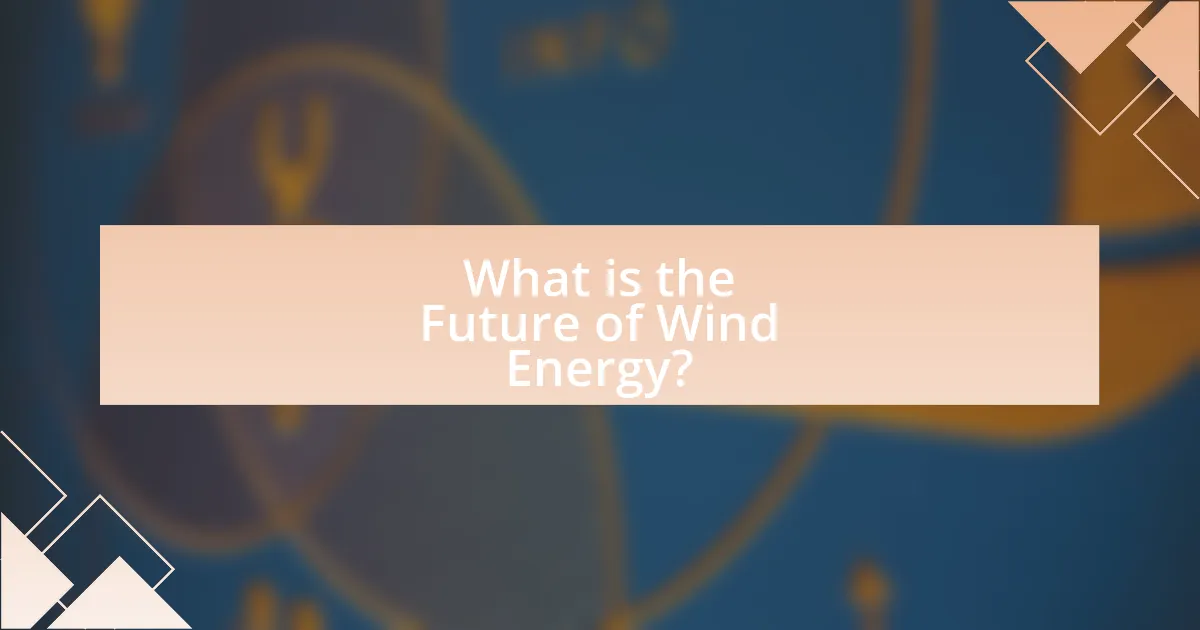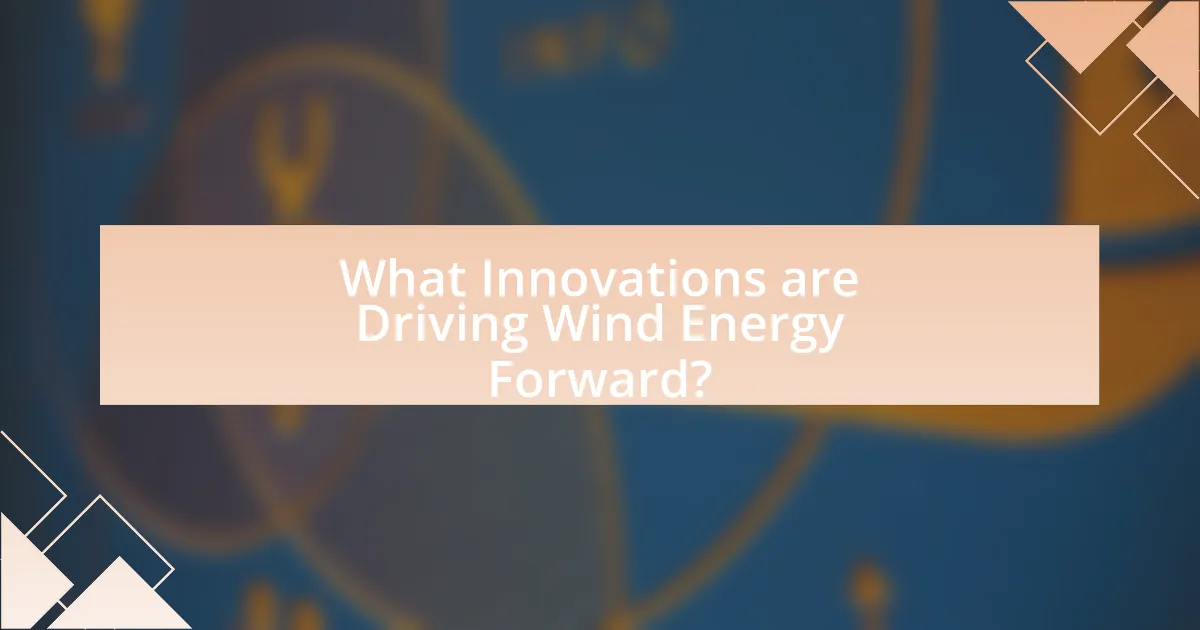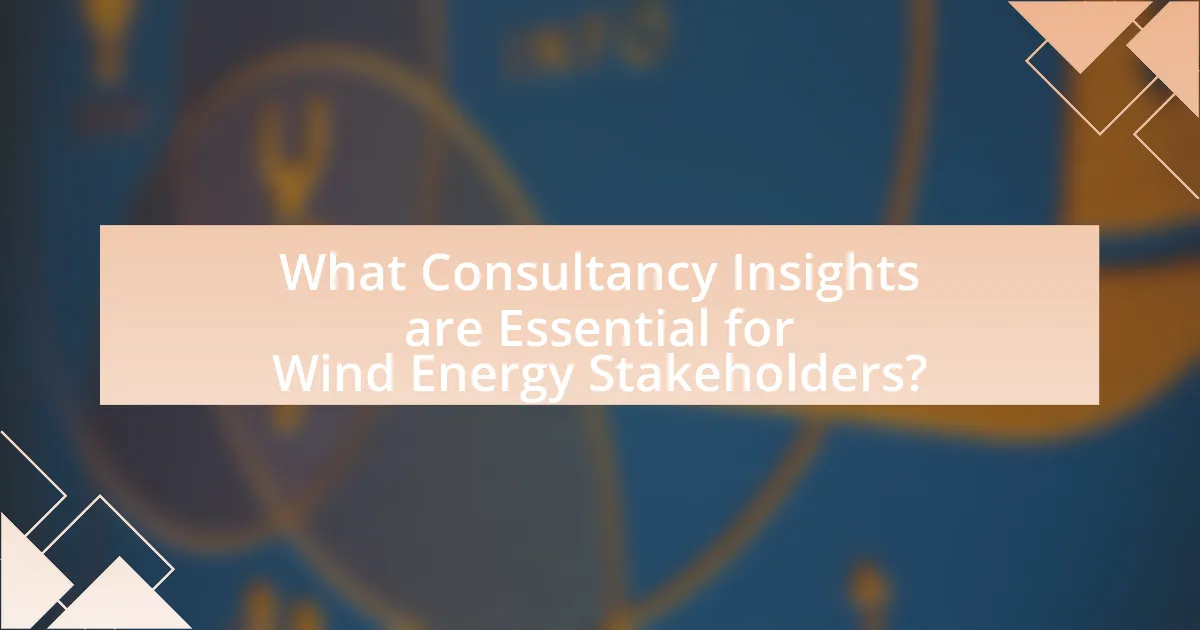The article focuses on the future of wind energy, highlighting significant advancements in technology and the increasing global demand for renewable energy. It discusses innovations such as larger and more efficient turbines, floating wind farms, and improved energy storage solutions that enhance the viability of wind energy. The article also examines the impact of policy changes on wind energy growth, the environmental benefits of wind power, and the role of consultancy insights in project development. Key trends in offshore wind energy, challenges faced, and effective financial models for investments are also addressed, providing a comprehensive overview of the evolving landscape of wind energy.

What is the Future of Wind Energy?
The future of wind energy is poised for significant growth, driven by advancements in technology and increasing global demand for renewable energy sources. Innovations such as larger and more efficient turbines, floating wind farms, and improved energy storage solutions are enhancing the viability and efficiency of wind energy. According to the Global Wind Energy Council, the global installed wind capacity reached over 743 GW in 2020, with projections indicating that it could exceed 1,200 GW by 2025, reflecting a compound annual growth rate of approximately 10%. This growth is supported by government policies aimed at reducing carbon emissions and transitioning to sustainable energy systems.
How is wind energy evolving in the modern landscape?
Wind energy is evolving rapidly in the modern landscape through advancements in technology, increased efficiency, and expanded applications. Innovations such as larger and more efficient turbines, which can generate more power at lower wind speeds, have significantly improved energy output. For instance, the average capacity of onshore wind turbines has increased from about 1.5 megawatts in 2000 to over 3 megawatts in 2020, according to the Global Wind Energy Council. Additionally, offshore wind farms are becoming more prevalent, with projects like the Hornsea One in the UK, which has a capacity of 1.2 gigawatts, showcasing the potential for large-scale energy generation. Furthermore, the integration of digital technologies, such as predictive maintenance and smart grid solutions, enhances operational efficiency and reduces costs. These developments indicate a strong trend towards wind energy becoming a cornerstone of sustainable energy systems globally.
What technological advancements are shaping the future of wind energy?
Technological advancements shaping the future of wind energy include larger and more efficient turbines, improved energy storage solutions, and enhanced predictive maintenance through artificial intelligence. Larger turbines, such as those exceeding 10 megawatts, can capture more wind energy and generate electricity more efficiently, as evidenced by the increasing deployment of offshore wind farms. Energy storage technologies, like lithium-ion batteries and pumped hydro storage, enable better integration of wind energy into the grid by addressing intermittency issues. Additionally, AI-driven predictive maintenance systems optimize turbine performance and reduce downtime, leading to increased operational efficiency. These advancements collectively enhance the viability and sustainability of wind energy as a key component of the global energy transition.
How do policy changes impact the growth of wind energy?
Policy changes significantly influence the growth of wind energy by altering financial incentives, regulatory frameworks, and market access. For instance, the introduction of tax credits, such as the Production Tax Credit (PTC) in the United States, has historically led to increased investments in wind projects, resulting in a 61% growth in installed capacity from 2015 to 2019. Additionally, policies that streamline permitting processes can reduce project timelines and costs, further accelerating deployment. Conversely, the removal of supportive policies can lead to market uncertainty, causing a decline in new wind energy projects, as seen in various regions where subsidies were cut. Thus, effective policy frameworks are crucial for fostering a conducive environment for wind energy expansion.
Why is wind energy considered a key player in renewable resources?
Wind energy is considered a key player in renewable resources due to its ability to generate electricity without emitting greenhouse gases. In 2022, wind power contributed approximately 9.2% of the total electricity generation in the United States, highlighting its significant role in reducing reliance on fossil fuels. Additionally, advancements in technology have led to increased efficiency and lower costs, making wind energy one of the most competitive sources of electricity. The International Energy Agency projects that wind energy capacity could reach 1,200 gigawatts globally by 2025, further solidifying its importance in the transition to sustainable energy systems.
What are the environmental benefits of wind energy?
Wind energy offers significant environmental benefits, primarily by reducing greenhouse gas emissions. Unlike fossil fuels, wind turbines generate electricity without releasing carbon dioxide or other harmful pollutants, contributing to cleaner air and mitigating climate change. According to the U.S. Department of Energy, wind energy has the potential to reduce carbon emissions by up to 329 million metric tons annually, equivalent to the emissions from 70 million cars. Additionally, wind energy conserves water, as it requires minimal water for operation compared to conventional power plants, which can consume thousands of gallons per megawatt-hour. This reduction in water usage helps preserve local water resources and supports ecosystems. Overall, wind energy plays a crucial role in promoting a sustainable and environmentally friendly energy landscape.
How does wind energy contribute to energy independence?
Wind energy contributes to energy independence by reducing reliance on imported fossil fuels. By harnessing local wind resources, countries can generate their own electricity, which decreases vulnerability to global energy market fluctuations. For instance, in 2020, wind energy accounted for 8.4% of total U.S. electricity generation, significantly displacing the need for coal and natural gas imports. This shift not only enhances national security but also promotes economic stability by keeping energy expenditures within the country.

What Innovations are Driving Wind Energy Forward?
Innovations driving wind energy forward include advancements in turbine technology, such as larger rotor diameters and higher efficiency designs. These innovations enable turbines to capture more wind energy and generate electricity at lower wind speeds, significantly increasing energy output. For instance, modern turbines can exceed 10 megawatts in capacity, with rotor diameters reaching over 200 meters, which enhances their performance in diverse wind conditions. Additionally, the integration of digital technologies, like predictive maintenance and data analytics, optimizes operational efficiency and reduces downtime, further contributing to the growth of the wind energy sector.
How are new technologies enhancing wind turbine efficiency?
New technologies are enhancing wind turbine efficiency through advancements in materials, design, and data analytics. For instance, the use of lighter and stronger composite materials allows for larger blades that can capture more wind energy, increasing overall energy output. Additionally, innovations in aerodynamic design optimize blade shapes, reducing drag and improving performance in varying wind conditions. Data analytics and machine learning enable predictive maintenance, allowing for timely repairs and minimizing downtime, which further boosts efficiency. According to a report by the International Renewable Energy Agency, these technological advancements have the potential to increase wind turbine efficiency by up to 20% over the next decade.
What role do smart grids play in optimizing wind energy usage?
Smart grids play a crucial role in optimizing wind energy usage by enhancing the integration and management of renewable energy sources. They utilize advanced communication and control technologies to balance supply and demand, allowing for real-time adjustments based on wind energy availability. For instance, smart grids can forecast wind patterns and adjust energy distribution accordingly, reducing waste and improving efficiency. According to the U.S. Department of Energy, implementing smart grid technologies can increase the capacity of wind energy integration by up to 30%, demonstrating their effectiveness in optimizing renewable energy systems.
How are materials science advancements improving turbine design?
Materials science advancements are improving turbine design by enabling the development of lighter, stronger, and more durable materials. These innovations allow for larger turbine blades that can capture more wind energy, thereby increasing efficiency and energy output. For instance, the use of advanced composites, such as carbon fiber reinforced polymers, has led to blades that are both lightweight and resistant to fatigue, which enhances their lifespan and performance. Additionally, the integration of smart materials that can adapt to environmental conditions further optimizes turbine operation, contributing to more reliable energy generation.
What are the latest trends in offshore wind energy development?
The latest trends in offshore wind energy development include the increasing deployment of larger turbines, advancements in floating wind technology, and a focus on hybrid energy systems. Larger turbines, such as those exceeding 12 MW, enhance energy output and efficiency, with manufacturers like Siemens Gamesa and GE Renewable Energy leading this innovation. Floating wind technology is gaining traction, allowing installations in deeper waters, which expands potential sites for development; projects like the Hywind Scotland demonstrate this capability. Additionally, hybrid energy systems that integrate offshore wind with other renewable sources, such as solar and energy storage, are being explored to optimize energy generation and grid stability. These trends reflect a significant shift towards more efficient and versatile offshore wind energy solutions.
How does offshore wind energy compare to onshore in terms of efficiency?
Offshore wind energy is generally more efficient than onshore wind energy due to higher and more consistent wind speeds found at sea. Offshore wind farms can achieve capacity factors of 50-60%, compared to 30-40% for onshore installations. This increased efficiency is attributed to fewer obstructions and turbulence over water, allowing turbines to operate at optimal performance levels more frequently. Additionally, studies indicate that offshore wind resources can produce up to 70% more energy than onshore sites in certain regions, reinforcing the advantages of offshore installations in harnessing wind energy effectively.
What challenges are faced in offshore wind energy projects?
Offshore wind energy projects face several significant challenges, including high initial capital costs, logistical complexities, and environmental concerns. High initial capital costs arise from the need for specialized equipment and infrastructure, with investments often exceeding billions of dollars for large-scale projects. Logistical complexities include the transportation and installation of turbines in remote marine locations, which can be hindered by weather conditions and require advanced maritime technology. Environmental concerns involve the potential impact on marine ecosystems and wildlife, necessitating thorough environmental assessments and regulatory compliance. These challenges can delay project timelines and increase overall costs, impacting the feasibility and attractiveness of offshore wind energy as a sustainable energy source.

What Consultancy Insights are Essential for Wind Energy Stakeholders?
Essential consultancy insights for wind energy stakeholders include market analysis, regulatory compliance, and technological advancements. Market analysis provides stakeholders with data on demand trends and competitive landscapes, enabling informed investment decisions. Regulatory compliance insights ensure that stakeholders adhere to local and international laws, which is crucial for project viability; for instance, the European Union’s Renewable Energy Directive sets specific targets for renewable energy usage. Technological advancements, such as improvements in turbine efficiency and energy storage solutions, are vital for optimizing performance and reducing costs, as evidenced by the International Renewable Energy Agency’s report indicating that the cost of onshore wind energy has decreased by 49% since 2009. These insights collectively empower stakeholders to navigate the complexities of the wind energy sector effectively.
How can consultancy services aid in wind energy project development?
Consultancy services can significantly aid in wind energy project development by providing expertise in project feasibility, regulatory compliance, and risk management. These services help assess site suitability through wind resource assessments, ensuring optimal turbine placement and energy production potential. Additionally, consultancy firms guide developers through complex permitting processes, leveraging their knowledge of local regulations and environmental impact assessments. For instance, a study by the International Renewable Energy Agency (IRENA) highlights that effective consultancy can reduce project delays by up to 30%, thereby enhancing overall project viability and financial returns.
What are the best practices for project feasibility assessments?
The best practices for project feasibility assessments include conducting thorough market analysis, evaluating technical requirements, assessing financial viability, and engaging stakeholders early in the process. Market analysis helps identify demand and competition, while technical evaluations ensure that the project can be executed with available resources and technology. Financial viability assessments involve detailed cost-benefit analyses and funding strategies, which are crucial for determining the project’s sustainability. Engaging stakeholders early fosters collaboration and addresses potential concerns, enhancing project acceptance. These practices are supported by industry standards, such as the Project Management Institute’s guidelines, which emphasize the importance of comprehensive feasibility studies in successful project execution.
How do consultants help navigate regulatory frameworks?
Consultants help navigate regulatory frameworks by providing expertise in compliance, risk management, and strategic planning. They analyze existing regulations and interpret their implications for specific projects, ensuring that organizations adhere to legal requirements while optimizing operational efficiency. For instance, in the wind energy sector, consultants may assist companies in understanding local, state, and federal regulations related to environmental impact assessments, permitting processes, and grid interconnection standards. Their guidance can lead to reduced project delays and enhanced regulatory compliance, as evidenced by studies showing that organizations utilizing consultancy services experience a 30% faster approval rate for renewable energy projects compared to those that do not.
What strategies can stakeholders adopt for successful wind energy investments?
Stakeholders can adopt several strategies for successful wind energy investments, including thorough market analysis, risk assessment, and collaboration with local communities. Conducting a comprehensive market analysis allows stakeholders to identify trends, demand, and potential barriers in the wind energy sector, which is crucial given that the global wind energy market was valued at approximately $100 billion in 2020 and is projected to grow significantly. Risk assessment helps stakeholders understand financial, regulatory, and environmental risks associated with wind projects, enabling them to make informed decisions. Additionally, collaborating with local communities fosters support and mitigates opposition, as community engagement has been shown to increase project acceptance rates by up to 50%. These strategies collectively enhance the likelihood of successful investments in wind energy.
How can risk management improve investment outcomes in wind energy?
Risk management can significantly improve investment outcomes in wind energy by identifying, assessing, and mitigating potential risks associated with projects. By employing risk management strategies, investors can minimize financial losses due to factors such as regulatory changes, technological failures, and market volatility. For instance, a study by the International Renewable Energy Agency (IRENA) highlights that effective risk management practices can lead to a reduction in project costs by up to 20%, thereby enhancing overall returns on investment. Additionally, incorporating risk management frameworks allows for better decision-making, ensuring that investments are aligned with long-term sustainability goals and market trends.
What financial models are most effective for wind energy projects?
Power Purchase Agreements (PPAs) and Feed-in Tariffs (FiTs) are the most effective financial models for wind energy projects. PPAs provide long-term contracts between energy producers and buyers, ensuring stable revenue streams, while FiTs guarantee fixed payments for energy produced, promoting investment stability. According to the International Renewable Energy Agency (IRENA), projects utilizing PPAs have seen a significant reduction in financing costs, with some achieving rates as low as 2.5% in recent years. This financial structure has been pivotal in driving the growth of wind energy, as evidenced by the increase in global installed capacity, which reached over 743 GW in 2020, largely supported by these models.
What practical tips can enhance wind energy project success?
To enhance wind energy project success, it is crucial to conduct thorough site assessments to identify optimal locations for wind turbine installation. Site assessments should include wind resource evaluation, environmental impact studies, and community engagement to ensure local support. For instance, projects that have conducted comprehensive feasibility studies, such as the Hornsea One offshore wind farm in the UK, have demonstrated increased efficiency and reduced operational risks. Additionally, securing strong partnerships with experienced stakeholders and leveraging advanced technology for turbine design and maintenance can further improve project outcomes.